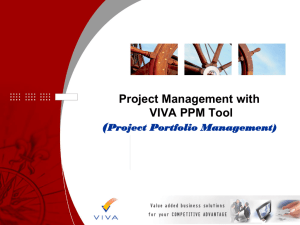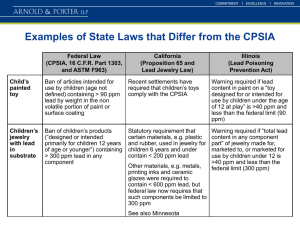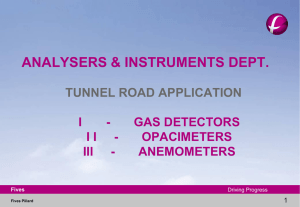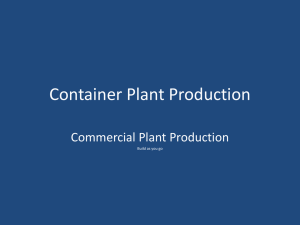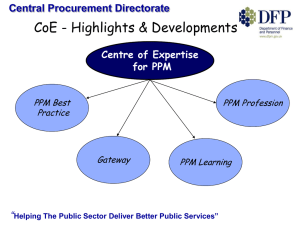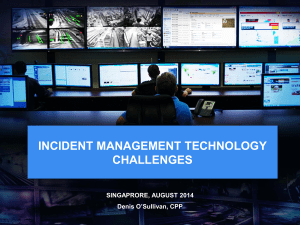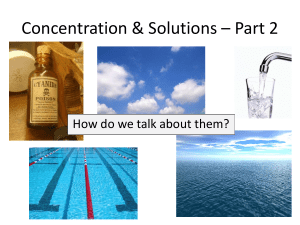Concept Phase - Office of the Accountant-General
advertisement
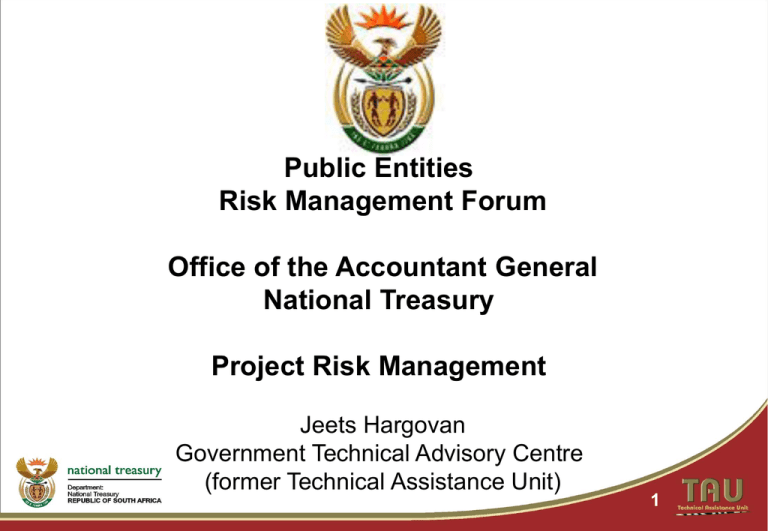
Public Entities Risk Management Forum Office of the Accountant General National Treasury Project Risk Management Jeets Hargovan Government Technical Advisory Centre (former Technical Assistance Unit) 1 The 7 Phases of a Project 1. Wild enthusiasm 2. Disillusionment 3. Confusion 4. Panic 5. Search for the guilty 6. Punishment of the innocent 7. Promotion of non-participants 2 Outline of Presentation Food for thought Proposed PPM Model PPM Logical Structure Proposed P M Model Placemats P M Framework and Methodology The 5 Phases Risk Management in PPM Conclusion 3 Food for Thought © Copyright http://www.dilbert.com/ 4 Food for Thought © Copyright http://www.dilbert.com/ 5 Triple Constraint (traditional) 6 Triple Constraint (traditional) 7 Which PPM • Options – – – – Project and Programme Management Programme and Project Management Programme, Portfolio and Project Management Etc . . . . . . • Current Framework: “Programme and Project Management” • It is not linked to Budget Programmes 8 Which PPM - 2 • Currently toolkits ONLY focus on Project Management • Based on Project Management Body of Knowledge (PMBOK) standards (3rd Edition) (as opposed to PRINCE2 (PRojects IN Controlled Environments – UK Government Standard) • Programme Management (from a national development perspective) being led by Presidency (e.g. Jobs Programme) 9 Objectives set for PPM •The overall objective of the PPM initiative was the development, implementation and support of a PPM framework and its associated methodologies and tools across the South African public service. •More specifically this includes: – The development of a PPM framework, guidelines and tools • Alignment to South African frameworks and tools (IDIP, DPSA, PPP) – Piloting and testing the PPM approach – Development of an introduction to PM e-training module – Support to NSG (PALAMA) – Alignment of material • Introduction to Project Management • Advanced Project Management – Development of a roll-out strategy and plan for Project Management • Include consultation with DPME and DPSA – Full roll-out and ongoing management and support – Included in FOSAD service delivery plans & Outcome 12 10 PPM Logical Structure Project Management Summary Guide Project Management Methodology Project Management Framework Health Check Guide Project Start Up Guide Charter Writing Guide Project Guides Sponsorship Guide Project Planning Guide Smaller Projects Guide PPM Office Set Up Guide Framework & Methodology People & Organisation Change Framework Concept Phase Tools Checklists Definition Phase Tools Placemats Planning Phase Tools Implementation Phase Tools Tools Close-Out Phase Tools Smaller Project Tools 11 Proposed PM Model Framework 9 knowledge areas Management People and Organisational change Phases 5 key phases each with a unique purpose and outputs 12 Project Management Toolkit Sections: 1) 2) 3) 4) 5) 6) Framework & Methodology Guides Concept Phase Tools Definition Phase Tools Planning Phase Tools Implementation Phase Tools 7) Close-Out Phase Tools 8) Smaller Projects Tools 13 P M Place Mat 14 Other Placemats • • • • • Executive Sponsor Health Check Guide Project Sponsor Project Start Up Success Factors Smaller Project Placemat 15 P M Framework 16 Link to P M Knowledge Areas 17 P M Methodology – 5 Phases The 5 phases cover what is necessary to complete a project The Concept & Definition Phases emphasise upfront planning and team building Concept Close-Out Implementation Definition Planning – The Concept Phase involves inventing & evaluating an initial idea and establishing it as a project – The Definition Phase involves starting the project and describing it in broad strokes – The Planning Phase involves describing the project in detail – The Implementation Phase involves doing and finishing the actual work – The Close-Out Phase involves winding down the project after the work is complete 18 How the Phases Work Objective Steps Concept Phase Objectives 1.1 to 6.1 Concept Definition Definition Phase Objectives Planning Implementation Close-Out Key Outputs Checkpoint Business Case #1 1.1 to 6.1 Charter #2 Planning Phase Objectives 1.1 to 8.1 Project Plan #3 Implementation Phase Objectives 1.1 to 9.4 Work Performed #4 Close-Out Phase Objectives 1.1 to 6.2 Project Closed Project End 19 Concept Phase • The purpose of the Concept Phase is to determine that a project is needed and, on a high-level, specify what the project should accomplish and who needs to be involved. • Projects will vary in terms of complexity, but all should have some level of initial concept definition. For some projects, it may take only a few days to complete this phase, for others, it could take months. The key questions that should be answered during the concept phase include: – – – What is to be done? Why is it to be done? How will it be done? • The main objective of this phase is to obtain official approval to formally initiate a project, and build the foundation for commitment among project partners and key stakeholders. This is accomplished through the creation and sign-off of the Business Case. 20 Concept Phase 1. Concept 2. Definition 3. Planning 4. Implementation 21 5. Close Out Definition Phase • Each project is unique and must be individually defined. The purpose of the Definition Phase is to define and add structure to the project. • The main objectives include determining the governance structure, hiring the project manager and core project team, and documenting the high-level scope of the project. • The phase ends with a clear documentation of the project outcomes and outputs, as well as the articulation of the key constraints for the project in terms of time, budget and number of resources. This is accomplished through the development of the Project Charter. 22 Definition Phase 1. Concept 2. Definition 3. Planning 4. Implementation 23 5. Close Out Planning Phase • The purpose of the Planning Phase is to ensure that all aspects of the project are identified, planned and appropriately documented. The main objectives include defining the scope of the project in detail and determining the required resources, time and money. The processes that will be used to monitor and control the project are also developed and documented as part of this phase. The phase ends with a clear documentation of all project processes and management plans, which is accomplished through the creation of the Project Plan. • A number of the objectives and steps provided below may be conducted concurrently, however, project participants should understand the interdependencies and linkages between various steps and how they come together to form the Project Plan. 24 Planning Phase 1. Concept 2. Definition 3. Planning 4. Implementation 25 5. Close Out Implementation Phase • The purpose of the Implementation Phase is to execute the tasks and activities that have been planned and documented in the Project Plan. • The main objectives of this phase include carrying out the work needed to complete project outputs and achieve project outcomes, while monitoring and controlling project’s progress and performance. The end of this phase is marked with the completion of all project objectives and outputs. 26 Implementation Phase 1. Concept 2. Definition 3. Planning 4. Implementation 27 5. Close Out Close Out Phase • The completion all project deliverables does not signify the end of the project. The purpose of the Close-Out Phase is to complete all outstanding project activities, arrange for knowledge transfer, and facilitate the transition to operations. • Furthermore, one of the main objectives of the Close-Out phase, in addition to documenting the formal acceptance of project results, is to identify, capture and properly archive the knowledge / lessons learnt and experiences gained as a result of having completed the project. The end of this phase marks the end of the project. • In addition to releasing the project’s physical and closing project’s financial assets, special attention should be paid to the project’s human resource assets. It is important to ensure that project team members are appropriately recognised and rewarded for their accomplishments and that their transition to the next engagement is made as smooth as possible. 28 Close Out Phase 1. Concept 2. Definition 3. Planning 4. Implementation 29 5. Close Out Risk Management in the PPM Framework 30 And Finally – Some things may not change © Copyright http://www.dilbert.com/ We are only fixing the world – one step at a time 31 Conclusion 32


